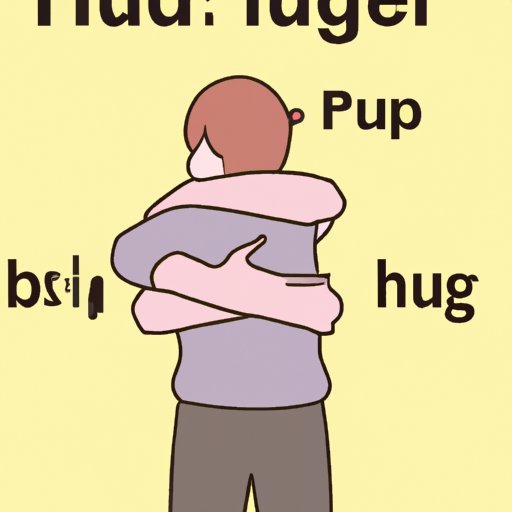Introduction
A hug is a gesture of affection that involves two people embracing each other with their arms. Hugs are often seen as a sign of love and acceptance, and they can be an important part of communicating feelings between people. But beyond being a simple gesture of affection, are hugs actually good for your health? In this article, we’ll explore the benefits and risks of hugging and look at the science behind the effects of hugs.
Exploring the Benefits and Risks of Hugging
Touch is an essential part of human contact and communication, and research has shown that it can have a powerful effect on our physical and mental health. Studies have found that touching or being touched by another person can reduce stress levels, improve mood, and even lower blood pressure. It can also help to build trust and connection between people.
However, there are potential risks associated with hugging. For example, if you’re not comfortable with someone or if the hug is too tight, it can cause discomfort or even pain. In some cases, it can lead to feelings of anxiety or fear. So while hugging can be beneficial in certain contexts, it’s important to consider the potential risks as well.

Examining the Health Impact of Human Touch
When it comes to understanding the health impact of hugs, one of the most important things to consider is the science behind the effects of touch. Studies have found that when we touch or are touched by another person, our bodies release oxytocin, a hormone that helps us feel connected and relaxed. Oxytocin has been linked to improved physical and mental health, including reduced stress levels and increased feelings of wellbeing.
In addition to oxytocin, touch can also stimulate the release of endorphins, which are natural chemicals that help to reduce pain and create a sense of pleasure and euphoria. Endorphins are thought to be responsible for the feeling of “runner’s high” that some people experience after exercise.
Research has also shown that touching or being touched by another person can boost immune system function, reduce inflammation, and even help to heal wounds faster. All of these benefits suggest that hugging can be an important part of maintaining good physical and mental health.

How to Give a Healthy Hug
If you want to get the most out of hugging, it’s important to be aware of the potential risks as well as the benefits. Here are some guidelines for giving a healthy hug:
- Be mindful of consent: Respect the other person’s boundaries and only hug them if they are comfortable with it.
- Make sure it’s not too tight: A hug should be gentle and comfortable, not a squeeze.
- Don’t linger: Allow the hug to last no longer than a few seconds.
- Be aware of body language: Pay attention to how the other person is responding and stop if they seem uncomfortable.
These guidelines can help to ensure that any hug you give is healthy and beneficial for both parties.
What Physical and Mental Health Benefits Can We Get from Hugging?
Now that we’ve looked at the potential risks of hugging, let’s take a closer look at the physical and mental health benefits that can be gained from this simple gesture. Here are some of the ways that hugging can benefit your health:
Physical Health Benefits
- Boosts immune system function
- Reduces inflammation
- Helps to heal wounds faster
- Lowers blood pressure
- Decreases stress hormones
Mental Health Benefits
- Reduces stress and anxiety
- Improves mood
- Increases feelings of safety and security
- Promotes feelings of connection and belonging
- Creates feelings of pleasure and euphoria
As you can see, there are many physical and mental health benefits that can be gained from hugging. However, it’s important to remember that everyone is different and some people may find hugging uncomfortable or even distressing. If you’re unsure, it’s best to ask before initiating a hug.

Understanding the Connection Between Hugs and Happiness
One of the most interesting aspects of hugging is the connection between hugs and happiness. Studies have found that people who receive more hugs tend to be happier and less stressed than those who don’t. This suggests that hugs can help to create a sense of wellbeing and satisfaction.
However, it’s important to note that some people may find it difficult to give or receive hugs. This could be due to past experiences or a fear of intimacy. If you find it hard to give or receive hugs, it’s important to be kind to yourself and seek support if needed.
Conclusion
In summary, hugging can be a great way to show affection and care for someone, as well as benefiting your physical and mental health. However, it’s important to consider the potential risks and be mindful of consent when giving a hug. With these guidelines in mind, hugging can be a healthy and enjoyable way to connect with others.
(Note: Is this article not meeting your expectations? Do you have knowledge or insights to share? Unlock new opportunities and expand your reach by joining our authors team. Click Registration to join us and share your expertise with our readers.)
